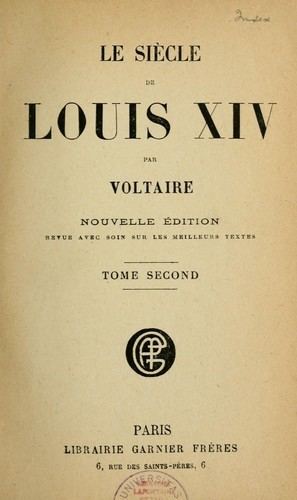Original title Le Siècle de Louis XIV Originally published 1751 Country France | Language French Publication date 1751 Genres History, Historiography | |
 | ||
Similar Voltaire books, History books | ||
The Age of Louis XIV ("Le Siècle de Louis XIV", also translated The Century of Louis XIV) is a historical work by the French historian, philosopher, and writer Voltaire, first published in 1751. Through it, the French 17th century became identified with Louis XIV of France, who reigned from 1643 to 1715.
Contents
Background
A letter in May 1732 is the first recorded mention of Voltaire's intent to write a history of the reign of Louis XIV. He stopped and resumed the project multiple times, expressing the fear that he might not live long enough to complete it. For preparation, he read two hundred volumes of material, plus many unpublished memoirs, as well as historical documents he found in the archives of the Louvre.
Content
In common with other Enlightenment philosophers, Voltaire saw the age of Alexander the Great and Pericles, the age of Caesar and Augustus, and the Italian Renaissance as "great ages" or "ages of light". He presented the age of Louis XIV as the fourth and greatest.
The period covered by the history does not correspond either to the 17th century nor to the reign of Louis XIV, but from the last years of Cardinal Richelieu to the years after Louis XIV's death. Voltaire described this age as the greatest ever in terms of arts and philosophy; the time coming closest to perfection. By praising a past age as the greatest ever, he implicitly criticised the culture and art of his own time – the mid-18th century, in the reign of Louis XV – as being in decline. The history consists of 36 chapters.
Voltaire repeatedly remarked that the work should be seen as less like a history but as like a painting: his main concern was not to document already noteworthy events but to celebrate the progress of reason and culture. He saw more greatness in the advance of art or the rejection of medieval superstition—for example, the release of everyone who had been imprisoned for sorcery—than in celebrated military victories. He described his own role as highlighting trends that others had not noticed, similarly to how a painter sees subtleties of light and colour that others miss.
Reception
The Protestant writer Laurent Angliviel de la Beaumelle published an annotated version of the book, Notes sur le siècle de Louis XIV, in 1753, adding many attacks against Voltaire.
In the early 19th century, the English writer Hannah More wrote that Voltaire had "decorated both the period and the king with so much that is great and brilliant, that they fill a large space in the eye of the reader." The American writer Virginia Randolph Cary wrote in 1828 that "Voltaire's General History, and his Age of Lewis XIV, will always be read with pleasure."
The publication of new editions of The Age of Louis XIV in the late 20th century helped to renew interest in Voltaire as a historian. Modern scholars have described it as "the foundational text of French literary history" and "a milestone on the road to modern history-writing".
